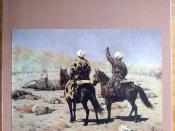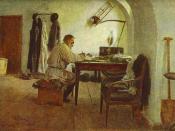Any theory that attempts to define art seeks to identify the necessary and sufficient conditions that are ever-present in what is known as art. For Tolstoy these conditions were that a piece of art must be borne of a feeling or emotion experienced by the artist, and in turn convey this emotion to the audience:
"Art is a human activity consisting in this, that one man consciously by means of certain external signs, hands on to others feelings he has lived through, and that others are infected by these feelings and also experience them." (Tolstoy, 'What is Art?').
While Tolstoy's theory of art (now commonly known as 'Expressivism') is a very bold attempt at defining art, and an extremely Romantic notion, it is not without numerous flaws (that we will later examine). Before critically evaluating Tolstoy's ideas however, it is worth looking at how art had been defined before the 19th century.
The earliest known definition of art to be established was that of the 'imitative' theory. This was put forward originally by Plato. He suggested that all art was an imitation. In fact, in relation to his theory of Forms, art was an imitation of an imitation. The Form, the perfect example of every object on earth, was imitated by its physical or metaphysical (in the case of colours) representation on Earth (i.e. the 'form' of a tree was imitated by all the trees on earth). Trees were in turn imitated by the artist's impression, or 'imitation' of them. Thus art was twice removed from the Forms (or the ultimate 'good' according to Plato), which resulted in him banning all art from his ideal state in 'The Republic'. Even up until the Italian Renaissance, art was concerned with portraying life with as...


